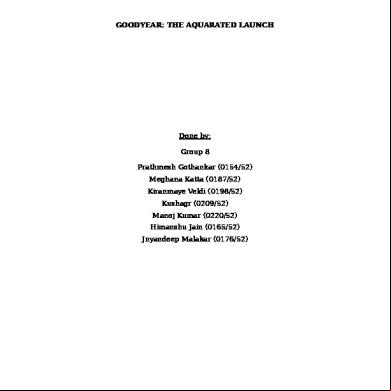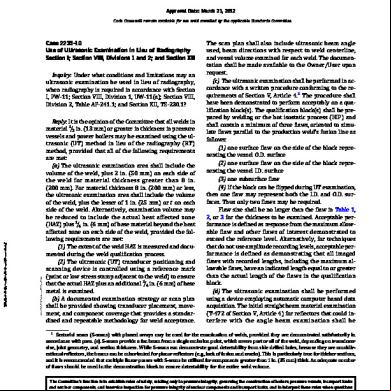Goodyear-the Aquatred Launch Case Analysis_group 10 176861
This document was ed by and they confirmed that they have the permission to share it. If you are author or own the copyright of this book, please report to us by using this report form. Report 3b7i
Overview 3e4r5l
& View Goodyear-the Aquatred Launch Case Analysis_group 10 as PDF for free.
More details w3441
- Words: 607
- Pages: 2
Case Analysis: Goodyear-The Aquatred Launch Group 10 Ataul Karim (P16005), Justin Fernandez (P16018), Sahil Jain (P16022), Rishi Kharbanda (P16028), Mainak Pradhan (P16042)
Background Consumer: Goodyear segmented tire buyers into four categories – price-constrained buyers, value-oriented buyers, quality buyers, commodity buyers. In 1992, 45% of tire buyers were price oriented, 22% were brand oriented and 33% believed the outlet was not important. Company: Goodyear operated 41 plants in the US, 43 plants in 25 other countries, 6 rubber plantations and more than 2000 distribution outlets worldwide. It ranked 3 rd in worldwide sales of new tires. It also had a strong track record in launching innovative products. Competitors: Michelin, Firestone, Uniroyal, BF Goodrich, Bridgestone, Uniroyal and General Tire. Michelin is the major competitor for Goodyear among value-oriented and quality buyers. Context: In the 1970s and 1980s, the US tire industry experienced three important changes- the emergence of the radial tire to replace the older “bias” and “bias-belted” tire constructions, increase foreign competition and change in the nature of demand from consumers and car makers were observed. In 1989, Goodyear started the NEWEX project, to develop a new and exciting replacement market tire. The Aquatred was developed after comparing 10 different designs on performance and consumer preference. Decision Problem Statement Is Aquatred the right product for the dealers and for the consumers? If yes, whether distribution should be expanded and if so, what specific channels or retailers should be added? Is it the right time to launch the Aquatred? Alternatives and their Evaluations 1. Goodyear to broaden its distribution to mass merchandiser and offer Aquatred Mass merchandiser focuses more Intensive distribution which comes with its own advantages and disadvantages Advantages: Intensive distribution through mass merchandiser can be done through small and large independent tire chains which would provide increased coverage and increased sales. Disadvantages: a) This strategy would help in the short run but it can hurt long term performance by eroding brand equity. b) Mass merchandiser focuses on volume which encouraging price wars which further erodes profitability c) Mass merchandiser sales are driven by promotional discounts while Aquarted product is priced at 10% over the standard product.
2. Goodyear to broaden its Distribution Channels focusing on Exclusive Dealership with the Aquatred To focus more on Selective distribution and reducing on the Intensive distribution Advantages a) Selective distribution will help in gaining adequate market coverage with more control and less cost than intensive distribution. b) Aquarted pricing and selective distribution will ensure that the product is of high quality and will attract the quality customers also. c) It will also ensure that the territory conflict is minimum among the distributors. Disadvantages a) Most customers of Goodyear are price-sensitive and hence market share in that segment may come down.
Recommendation and Outcomes Aquarted product is a patented technology and its launch will ensure that Goodyear is innovation driven company. To move from the promotional discounts, company should focus on the ment and try to attract the customers through the quality features of the product. The launch of Aquarted during winter Olympics is a right decision as the product is in initial phase and hence extensive marketing is needed. Price of the product should be kept slightly high (810%) so that the price-oriented customers as well as quality oriented customers could be targeted. For distribution purpose, selective distribution model should be adopted to gain the market coverage with more control. So our outcome is that Goodyear should launch the Aquarted product keeping in mind the following recommendations: pricing Launch during winter Olympics Selective distribution channels Invest more in ment than promotions
Background Consumer: Goodyear segmented tire buyers into four categories – price-constrained buyers, value-oriented buyers, quality buyers, commodity buyers. In 1992, 45% of tire buyers were price oriented, 22% were brand oriented and 33% believed the outlet was not important. Company: Goodyear operated 41 plants in the US, 43 plants in 25 other countries, 6 rubber plantations and more than 2000 distribution outlets worldwide. It ranked 3 rd in worldwide sales of new tires. It also had a strong track record in launching innovative products. Competitors: Michelin, Firestone, Uniroyal, BF Goodrich, Bridgestone, Uniroyal and General Tire. Michelin is the major competitor for Goodyear among value-oriented and quality buyers. Context: In the 1970s and 1980s, the US tire industry experienced three important changes- the emergence of the radial tire to replace the older “bias” and “bias-belted” tire constructions, increase foreign competition and change in the nature of demand from consumers and car makers were observed. In 1989, Goodyear started the NEWEX project, to develop a new and exciting replacement market tire. The Aquatred was developed after comparing 10 different designs on performance and consumer preference. Decision Problem Statement Is Aquatred the right product for the dealers and for the consumers? If yes, whether distribution should be expanded and if so, what specific channels or retailers should be added? Is it the right time to launch the Aquatred? Alternatives and their Evaluations 1. Goodyear to broaden its distribution to mass merchandiser and offer Aquatred Mass merchandiser focuses more Intensive distribution which comes with its own advantages and disadvantages Advantages: Intensive distribution through mass merchandiser can be done through small and large independent tire chains which would provide increased coverage and increased sales. Disadvantages: a) This strategy would help in the short run but it can hurt long term performance by eroding brand equity. b) Mass merchandiser focuses on volume which encouraging price wars which further erodes profitability c) Mass merchandiser sales are driven by promotional discounts while Aquarted product is priced at 10% over the standard product.
2. Goodyear to broaden its Distribution Channels focusing on Exclusive Dealership with the Aquatred To focus more on Selective distribution and reducing on the Intensive distribution Advantages a) Selective distribution will help in gaining adequate market coverage with more control and less cost than intensive distribution. b) Aquarted pricing and selective distribution will ensure that the product is of high quality and will attract the quality customers also. c) It will also ensure that the territory conflict is minimum among the distributors. Disadvantages a) Most customers of Goodyear are price-sensitive and hence market share in that segment may come down.
Recommendation and Outcomes Aquarted product is a patented technology and its launch will ensure that Goodyear is innovation driven company. To move from the promotional discounts, company should focus on the ment and try to attract the customers through the quality features of the product. The launch of Aquarted during winter Olympics is a right decision as the product is in initial phase and hence extensive marketing is needed. Price of the product should be kept slightly high (810%) so that the price-oriented customers as well as quality oriented customers could be targeted. For distribution purpose, selective distribution model should be adopted to gain the market coverage with more control. So our outcome is that Goodyear should launch the Aquarted product keeping in mind the following recommendations: pricing Launch during winter Olympics Selective distribution channels Invest more in ment than promotions










